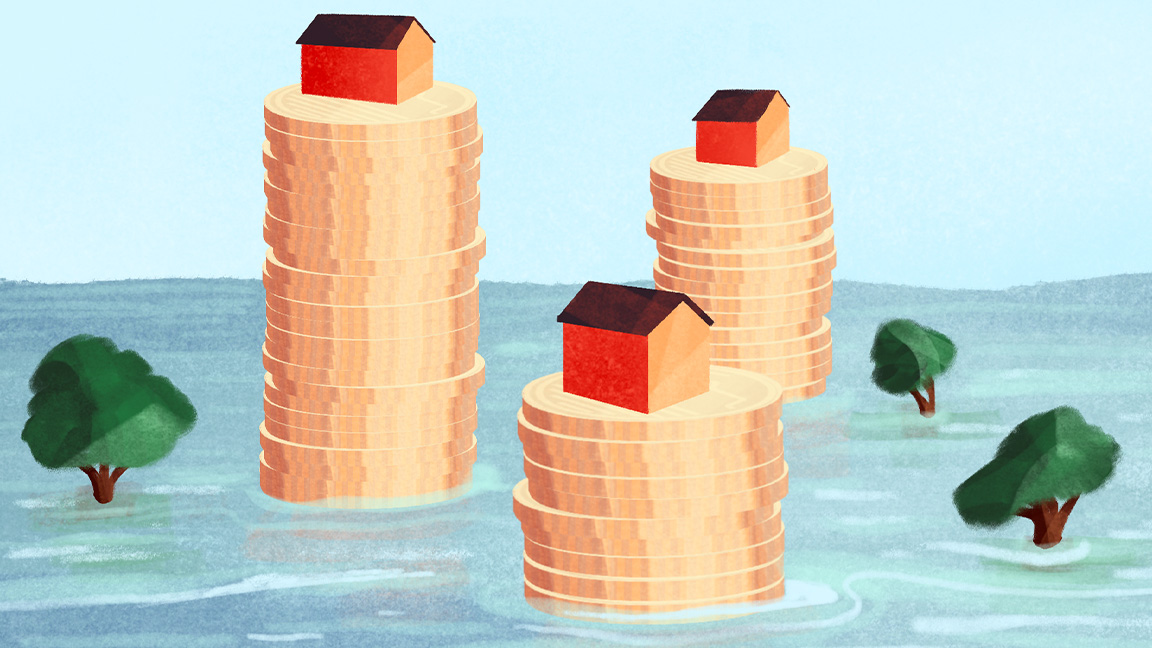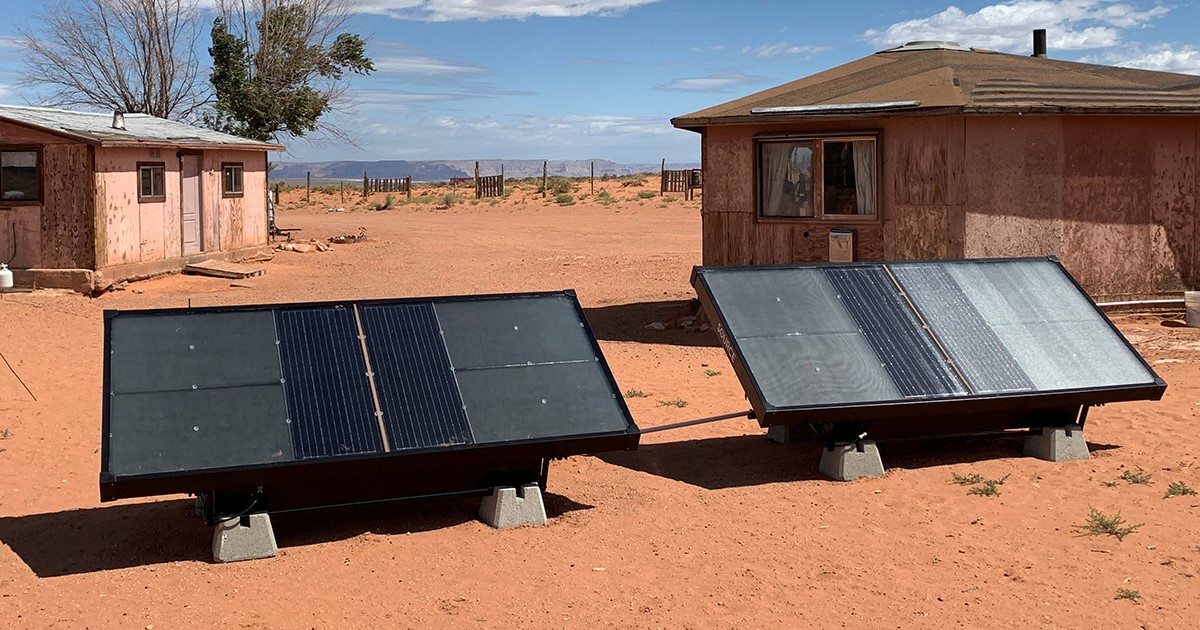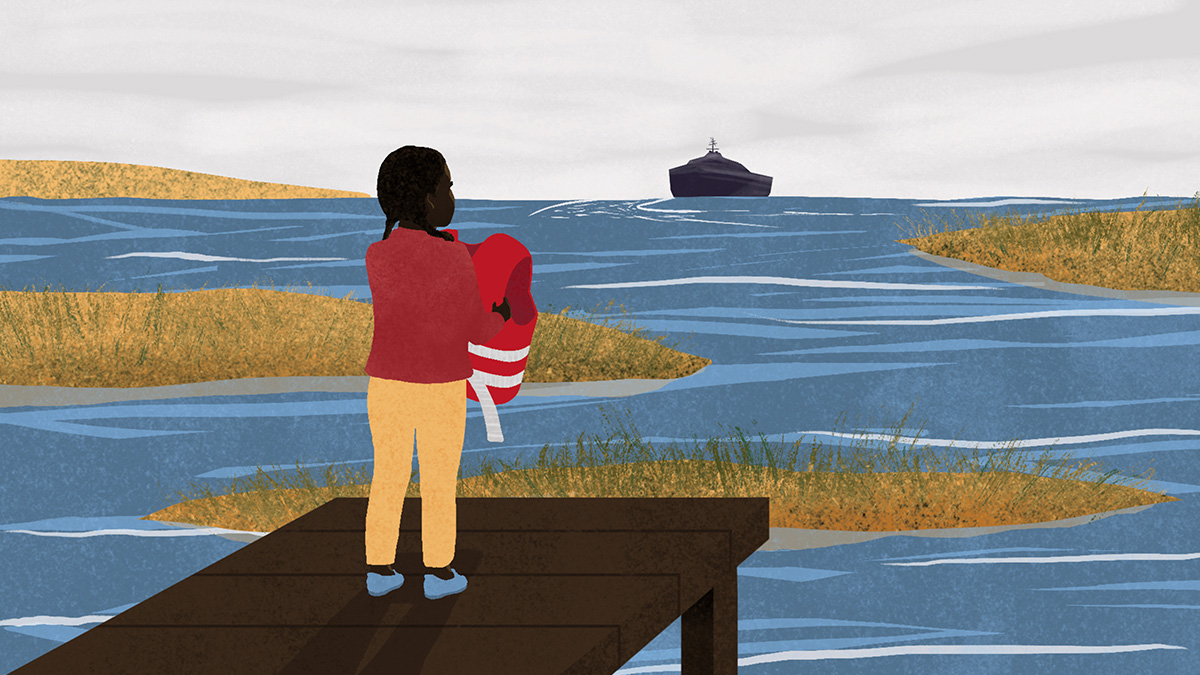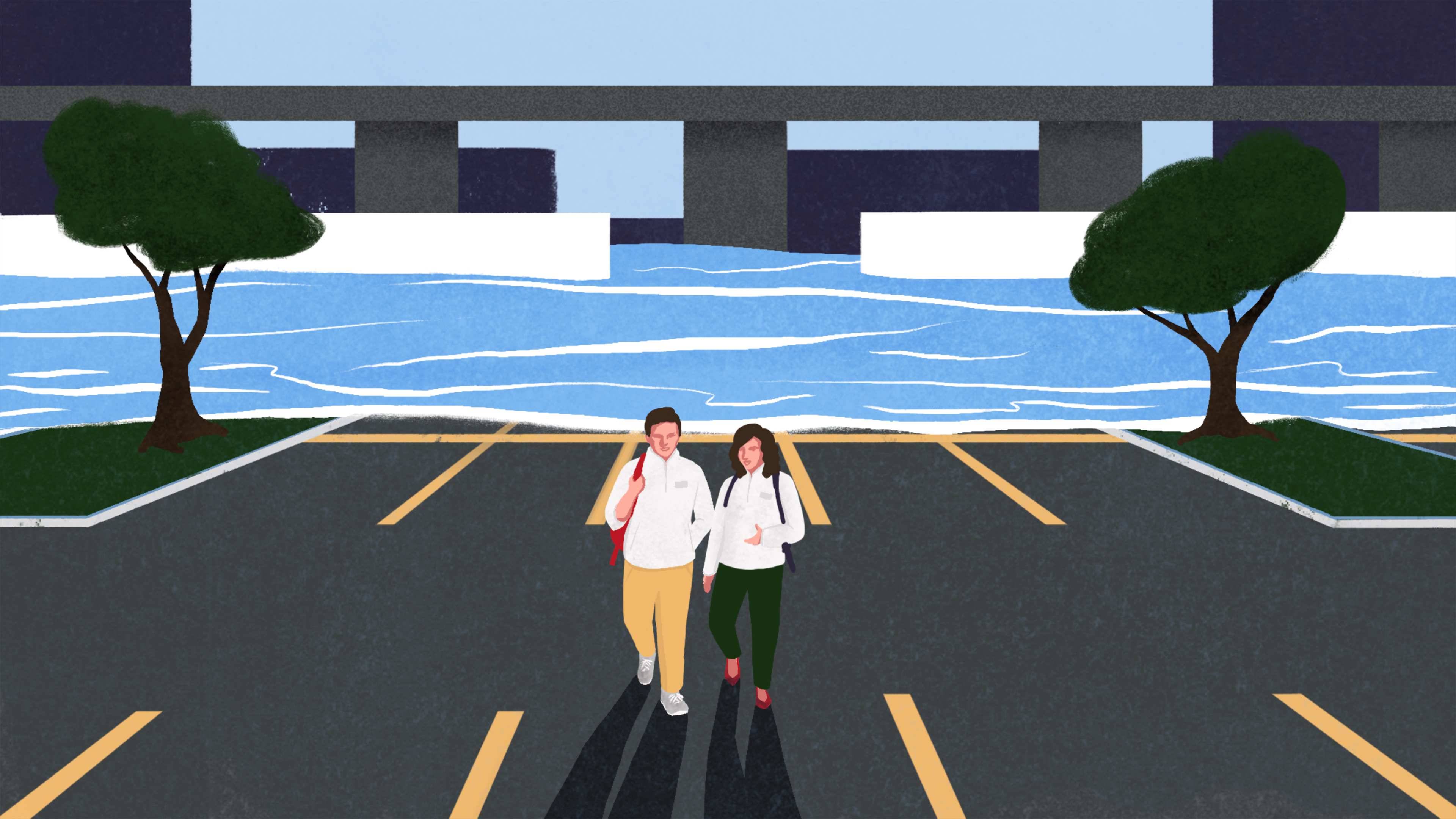
How We Survive: Staving off drought and living with fire
Columbia University researchers warned in April that the western United States might be entering a 20-year mega-drought. Human-caused climate change is one reason. And drought is an even bigger problem in places that have uneven access to water in the first place.
In the Navajo Nation in the Southwest, numbers vary but between 15% and a third of the population have no running water or access to clean drinking water. The need has been even greater during the coronavirus pandemic because people need more water for hand-washing and sanitation to stop the spread.

One potential solution comes from the startup Source, which makes Hydropanels — solar-powered panels that pull water vapor from the air and condense it into clean drinking water. A household system can produce up to 10 liters of water a day. It’s not cheap — it costs $6,000 — but private grants are funding access across the reservation.
Milton Tso is president of the Cameron chapter in the Navajo Nation, where one home received Source panels this summer. He described the water they make.
Milton Tso: When I was a child, when we went out hunting for small game, my grandfather … when the storm went through, you would have craters in the sandstone that held water. We used to bend over and drink the water out of these craters, and it was pure rainwater. When I first tasted [Hydropanel] water, I just flash back to that part of my memory. So that’s what the water tasted like. It’s just really clean and pure water. Like it came from the rain.
Molly Wood: And is it the one family in Cameron that has them right now?
Tso: Right now, yeah. I mean, this [is] people that don’t have running water. Some of them have to drive an hour and a half one way to town to get drinking water. People say, “Well, water is not expensive.” Sure, if you have access to the store, it’s around the corner, yes. For us, the reality is that just going to the town of Flagstaff [in Arizona], you’re spending maybe $50 on gas and other things, when you go buy water in town. So a case of bottled water [is] actually costing you around $60, $80.
Wood: How often do people have to go? Can you estimate how much a month that might cost, and how much somebody is, maybe this one household, is saving with the Hydropanels?
Tso: I would think they would go probably three days out of the week to get water. But we also have folks that still rely on their livestock — sheep, cattle, horses — so they’re running almost daily to haul water.
Wood: More broadly, when you look at bringing infrastructure to Cameron and the Navajo Nation — Hydropanels, but also renewable energy, new electric grids — do you feel hopeful that the reservation has a chance to maybe create a new vision of energy and water that isn’t so destructive?
Tso: One of the things about climate change, also, is that we get more sunlight now. And I think the tribe itself has a lot of interest in renewable energy. And this energy developed in our community in Cameron could be sold to California and surrounding states. At the same time, we also would like [a] smaller scale of solar energy to homes that are off the grid. That way, we don’t have to run more wires on our land, which is such an eyesore to me. There’s a price you pay, and that price is not only going to be coming out of your pocket, but are you willing to sacrifice the beauty of the land to get power?
Wood: I mean, do you think that can become a model for the rest of the country and other parts of the world?
Tso: I always tell people that are interested in trying something new in Cameron: “We’re willing to try it here. Be the first. If it works here, it’ll work anywhere.”
Seventeen homesteads on the entire reservation now have Hydropanels. Source says it’s working with the tribe to install panels on 500 more homes.
The Navajo Nation’s story is only one example of how climate change is a problem of inequality. Environmental justice is the idea that the effects of climate change are disproportionately felt in poor countries, poor communities and often by people of color.

So building resilience can’t only be about one home, one tribal chapter, one town at a time. Melissa Roberts is the founder and executive director of the nonprofit American Flood Coalition. She says some people and communities will be able to pay to lift their homes or take other measures to avoid floodwater. “And those with the least means who are often in harm’s way already won’t be able to do those things,” Roberts said. “That’s just not a system that makes our community or country resilient. And that just is not fair.”
In fact, Roberts said, when it comes to flooding in particular, sometimes adaptation can make things better for one place and worse for another. “Water often has to go somewhere. So when one community builds a levee next to a river that can overtop and flood the community, that levee will prevent the water from coming into the community it’s protecting. But once it gets pushed back from that community, it can actually rebound and make the flooding worse in surrounding communities that don’t have levees.”
This idea that wealthier communities create adaptation measures that can actually hurt other, poorer towns? Jalonne White-Newsome says this is not a new problem. She works with water systems at the Kresge Foundation. “You can look over the past decades and see that it is the same communities, the same folks that continue to get the short end of the stick.”
She said that systemic inequality simply won’t work for climate adaptation because even if some people move away or some towns pay for resilience measures and expect the people left behind to deal with the changing climate, “ultimately this is going to be an even larger burden on society and an even larger burden on the economic line of many of these communities. Because you’re going to have to pay for it eventually.”
That kind of coordination and systemic change will take new policy but also support from business. And big tech companies are starting to make water management part of their portfolios. This fall, in response to water shortages made worse by climate change, Microsoft committed to being water-positive by 2030. That means it will both reduce its water use and replenish the water it uses. Intel made a similar pledge last year.
Microsoft also says it wants to create products and data that other companies can use to manage their own water. Lucas Joppa is Microsoft’s chief environmental officer. He says there’s a lot of opportunity for tech solutions. “One of the things that’s been most exciting about the technology sector, I think, over the past couple of years, is really this ability to put internet-connected sensors to be able to start saying, hey, there’s not just water flowing through these pipes, we think, but there’s actually X amount of water at Y time of Z quality,” he said.
Joppa says Microsoft can use this data internally, but over time turn it into a product that other companies can use to manage their own water. Because the thing about climate change is that it’s a business risk that’s only going to get bigger. But according to Joppa, this is a chance for the tech industry to do what it says it does best.
“It’s a societal risk. It’s an existential human risk. Business is part of all of that, so it’s also a business risk. It’s also a huge and hugely exciting opportunity. If you are in any business right now, but technology in particular, hopefully you are inspired by bringing what makes your business special to the task of solving big, hard, gnarly problems, both because they’re hard problems and you want to help, and also because if they’re that big and they’re that hard, then surely the rewards of solving them are going to be significant as well,” he said.

“Of course, we’re trying to minimize that downside as well — any business should be right now — but I wouldn’t say that that’s what drives our motivation. It’s really thinking about all of these issues as one of the biggest big data problems our species has ever seen. One of the biggest compute problems our species has ever seen. One of the biggest markets that our society operates, and one of the biggest existential challenges that we’ve ever faced. I mean, when you look at the union of those four things, and you don’t see incredible excitement and incredible opportunity, I just think you need to look again.”
Drought leads to fire. Lots of it. 2020 was the worst year ever for wildfires in the United States. In California alone, more than 4 million acres burned, dozens died and thousands of structures were destroyed. And it’s increasingly clear that we’re going to have to figure out how to live with it. Kimiko Barrett is a research and policy analyst for Headwaters Economics, a think tank based in Bozeman, Montana. She said we need to rethink how we build houses, where we build them and even what they look like.
Kimiko Barrett: There’s been a lot of innovation in just recent years. But there is a large component when you’re starting to talk about replacement materials that are higher ignition-resistant or noncombustible. There’s a visual aesthetic that needs to be negotiated there with how homeowners’ preference is. Newer products are coming out to really try and mimic and look visually like that traditional building product because people don’t want to lose that feel of living in a log cabin in the woods. And so now products are coming out like concrete logs that look and feel very much like a wood product. It’s still kind of coming up to speed, and I think a bigger piece of it is just the outreach to homeowners that they know that these products are available. And then there is a cost comparison you have to think about and the differential cost that you’re going to look at with respect to, say, a metal roof and contrast to an asphalt-shingled roof.
Wood: What are the incentives that could push homeowners in that direction? Like, we see a lot of federal subsidies for things like solar. Could we start to see states or even the federal government do some kind of subsidy for more fire-resistant buildings?
Barrett: Sure, yeah. I think there’s two big incentives — one would certainly be the fiscal piece, and that’s what you’re getting at with the subsidies. The other big one is society’s embracement of understanding in that we are living in a very wildfire-prone landscape at this time, and that given ongoing trends, that these challenges, these risks, are only going to increase into the future. We need to start thinking about how we’re building differently. And homes that continually need to be rebuilt, homeowners are going to come to that point where it’s a transformative event for them. They’re going to want to build a home that can withstand a wildfire. And so then there’s another marketing piece there that can actually be pushed: subdivisions that have been built to higher wildfire resistance standards being marketed as a community that’s fire-wise and that’s set up to mitigate wildfire risks. That is another kind of educational outreach component that is yet to really reach the market, but I see a lot of value in that in the future.
Wood: I mean, we know that all of this development in these wildland-urban interfaces, [or] WUIs, is a part of what’s causing houses to burn down more frequently, for example. And I wonder, is there a danger if we think that we can construct fire-safe communities or fire-resistant houses, that then we’ll think, great, now we can build anywhere?
Barrett: Absolutely. We, and I say “we” within the wildfire research community, would never articulate any new building or development as fireproof that doesn’t exist. And I think that needs to be recognized, that you cannot build any sort of structure that’s going to have total, 100% fireproofness against a wildfire event. What you’re trying to do is to build a home that can withstand a wildfire and build in resiliency into the actual property and landscaping itself. And so that when a wildfire does come through, you’re buying not only yourself some time to collect your things and evacuate, if needed, but also for firefighters to come in and suppress that fire and be very effective with the resources that they have. So that’s really the idea. Certainly there is this potential devil’s advocate side that it’s a free-for-all, given development now in wildfire-prone landscapes, because you’re building a home that’s higher ignition-resistance, but right now, we’re not doing any of that.
As Barrett said, there is demand for homes that are built with fire-resistant parts. Well, we found one. In Marin County in California, just north of San Francisco, there’s a home that was built specifically to be as fire-resistant and self-sufficient as possible.
The house has hardly any wood, metal trusses for maximum airflow, a sprinkler system, solar panels and a backup power system for when the power goes out. It’s a luxury home, to be clear. It’s also got a pool, a sauna and views of Mount Tamalpais. It was listed at just under $4 million and sold in early December.
Fani Hansen is the architect. She was born in Bulgaria and now works in the Bay Area. She gave me a tour.
Fani Hansen: This particular valley is known to be very dangerous, as far as the fire. And the fire marshal made, actually, the greatest compliment to me by coming in saying, “This is the house that has to be a standard house.” In fact, it’s because also [it’s made from] a sustainable material, it’s recyclable completely, so you don’t really lose anything. Practically, with this, we did it in the shops, so there was almost zero left over and very little material that came into [the] site and had to be wasted.
Wood: You can almost prefabricate.
Hansen: Yes. In fact, thank you, because most of the parts are prefabricated. In architecture, to really be good, it is a combination of lots of parts. And those parts, if they are economical, the costs get reduced substantially. You can see, now, the trusses are very standard, used in the industrial area, and very inexpensive.
Wood: So what are the primary materials? Is it steel, concrete, glass? That’s pretty much it?
Hansen: Pretty much it. So now, this is the big space. And this is a space for both living, working, enjoying, playing — anything. Now, it opens on both sides. So when you sit here, Mount Tamalpais, which is of course the landmark, and it’s incredible because the views change every time. The sun comes and it just goes down and spills, and it’s a painting, which changes all the time.
Wood: This is an expensive house, and part of that is, of course, where we are: in California. But I wonder, do you think that this kind of building can translate into other wildland-urban areas?
Hansen: Absolutely. In fact, I really think this is the way to build in the future because you can use standard components and incorporate them in a creative way to respond to the need, because the need is different than it was even a year ago. And the costs are really tremendous, so it has to be — put all the parts together that could be done somewhere else and assemble on the site.
Wood: So this really could become an affordable way to build in new developments or for new houses?
Hansen: Oh, absolutely. In fact, I really think the cost of the air conditioning just takes one component. I think [the] majority of California has such a beautiful climate, and you can see now, opening on one side, opening on the other, the air goes through — you almost feel like you are in a tent and one feels 100 times better. It moves the leaves, the pattern changes, and it creates [an] incredible artistic interpretation of — really, we have this wonderful world and we’re just bringing it in.
Wood: Plus, you really save a lot of money on art. I mean, with all these big, glass walls, you don’t have to spend so much money.
Hansen: Well, that’s true because the art is outside.
Fire, flood and other disasters have another side effect: The power goes out. So battery technology is racing to create ways to store power locally and safety.
Click here to read and listen to Part 1 on the changing climate mindset.
Click here to read and listen to Part 3 on battery technology and green finance.
“How We Survive: Adapting to Climate Change” was edited by Michael Lipkin and produced by Stephanie Hughes with help from Jesús Alvarado and Rose Conlon. Scoring and engineering by Robyn Edgar and Ben Tolliday. Original music composed by Ben Tolliday.
As a nonprofit news organization, our future depends on listeners like you who believe in the power of public service journalism.
Your investment in Marketplace helps us remain paywall-free and ensures everyone has access to trustworthy, unbiased news and information, regardless of their ability to pay.
Donate today — in any amount — to become a Marketplace Investor. Now more than ever, your commitment makes a difference.
